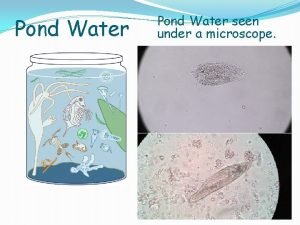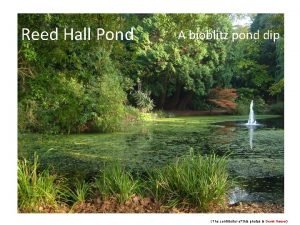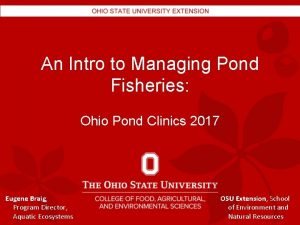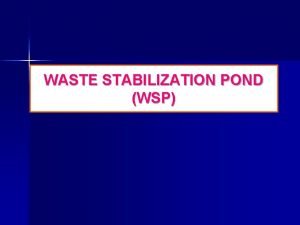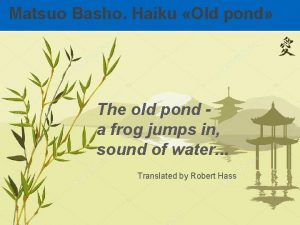Klondyke Water Storage Facility overview Pond Design Pond









- Slides: 9

Klondyke Water Storage Facility overview

Pond Design • Pond is constructed from soils excavated from within the footprint. • Pond is lined with a imported synthetic liner. • Pond is fed directly from the Rangitata Diversion Race (RDR). • Pond delivers water to the MHIS and therefore frees up canal flow for two other existing schemes and other users. • Water can be spilled into the Rangitata River and the RDR if required to maintain the full supply level. • The discharge of water into the Rangitata River is via a natural gully that will be reengineered for this purpose.

Design Standards • Pond is classified as a High Potential Impact Dam as defined by the NZSOLD Dam Safety Guidelines (2015). • Because of classification the pond would be designed for 1 in 10, 000 annual exceedance probability earthquake and probable maximum flood. • Earthquake resistance is provided by nature of the foundation and embankment soils and slopes adopted. • Flood resistance is provided by being able to spill both to the Rangitata River and the RDR. • The design details will be furthered developed and peer reviewed in detail in order to obtain a Building Consent.

Canal Modifications • Additional 10 m 3/s will raise water level by approximately 0. 5 m • Parts of the canal will require the canal bank to be raised and in a small number of areas widened • Most of the work on canal can be undertaken independent of operation. • Three bridges will need to be replaced • Dam break Assessment - Three areas highlighted where canal constructed in fill. Canal is assessed as Low PIC. • Construction will be mostly be earthworks to raise the canal bank levels based on Design drawings. • Three new bridges will to be constructed (to replace three existing bridges)

Fish Screen • • • Rotary Cylinder Fish Screens Design to exclude native fishery and Salmon/Trout Rotary Cylinder Fish Screen Located upstream of existing Fish Screen Can be constructed offline from RDR Design to achieve all criteria in the NIWA Fish Screen Guidelines including: • Average Approach Velocity < 0. 12 m/s • Sweep Velocity > Approach. (Average 1 m/s for Sediment Management) • Fish Bypass designed to enable safe passage of fish back to river. • Fish screen – 2 mm wedgewire • Construction will be mostly in cut. • Main construction is excavation of new canal, fish screen structures (concrete) and fish bypass. • The offline construction means the construction can mostly be undertaken with no effects on existing users. Fish Screen Layout Schematic Fish Screen Location

White Water Course • Proposed to construct a Recreation wave at the outlet of the proposed Klondyke Storage Facility. • The WWC will provide recreational use when water is released to the Mayfield Hinds Irrigation Scheme (MHV). • The storage facilities, disposal areas, and erosion control measures already in place for the storage pond are available for the construction of the WWC. • Construction includes control gate and weir as well as carpark and toilet facilities.

Flow Management Regime Rangitata River • Water Conservation Order 2006 sets flow management regime for the Rangitata River • Abstraction of water from Rangitata River cannot exceed 33 m 3/s unless the naturally occurring flow at Klondyke exceeds 110 m 3/s. 33 m 3/s block • A total of 33 m 3/s can be abstracted from the ‘reliable block’ of water which is fully available when flows in the Rangitata River at Klondyke are at or above 66 m 3/s. • Full 33 m 3/s is currently allocated and RDRML has an allocation of 30. 7 m 3/s in this ‘reliable block’. • No (further) abstraction of water when flows are between 66 and 110 m 3/s. High flow allocation • When flows at Klondyke are above 110 m 3/s water may be abstracted on a pro-rata basis. • Currently 22. 6 m 3/s of this high flow water is allocated in the Rangitata River

Existing and proposed RDRML takes and diversions Existing • Take of up to 30. 7 m 3/s from the Rangitata River for irrigation, stockwater and hydro - generation. • Divert up to 3 m 3/s for the existing fish bypass between approximately 10 September and 15 March. Proposed • Take an additional 10 m 3/s from the Rangitata River in accordance with the Water Conservation Order when flows at Klondyke are above 142. 6 m 3/s. • Standard pro-rata restrictions when flows are between 132. 6 and 142. 6 m 3/s and no take below 132. 6 m 3/s. • Divert up to 5 m 3/s for fish bypass purposes (year round). Table: Proposed Fish Bypass Diversion Flows (m 3/s) Rangitata River at Klondyke Flows Proposed Fish Bypass Flow > 142. 6 5 > 132. 6 and < 142. 6 4 <132. 6 3

Ecological Refuge Native plantings and habitat for birds, invertebrates, lizards 1 ha of re-located/new stone piles as lizard habitat 3 ha of plantings of broadleaf/hardwood, open shrubland/grassland 2 ha of wetland
 Water and water and water water
Water and water and water water Post stocking management
Post stocking management Physical media storage
Physical media storage Overview of storage and indexing
Overview of storage and indexing Primary storage vs secondary storage
Primary storage vs secondary storage Primary storage and secondary storage
Primary storage and secondary storage Secondary storage provides temporary or volatile storage
Secondary storage provides temporary or volatile storage Object based and unified storage
Object based and unified storage Unicellular fungi examples
Unicellular fungi examples Pond water
Pond water








